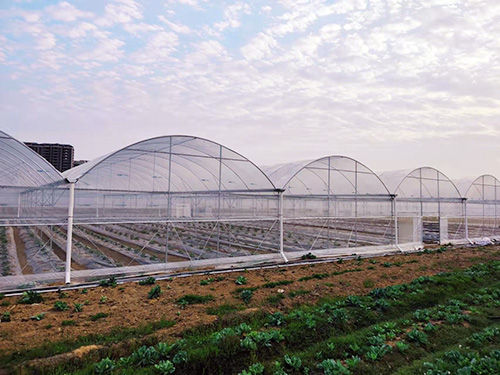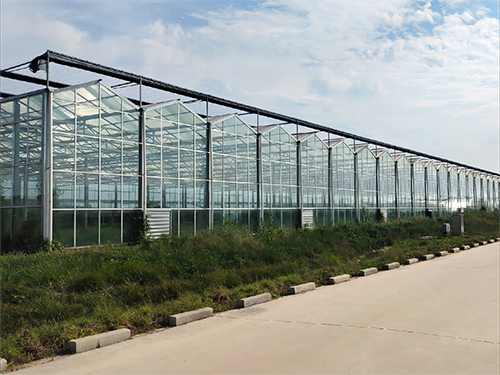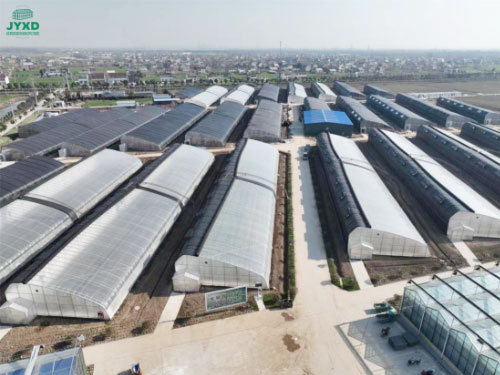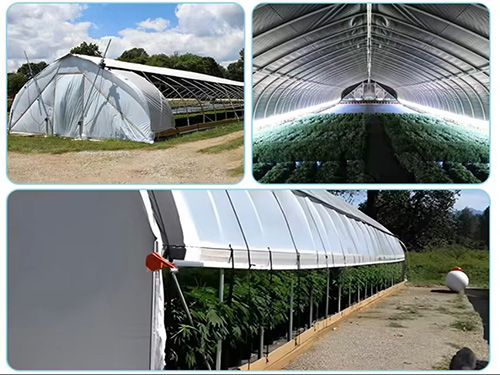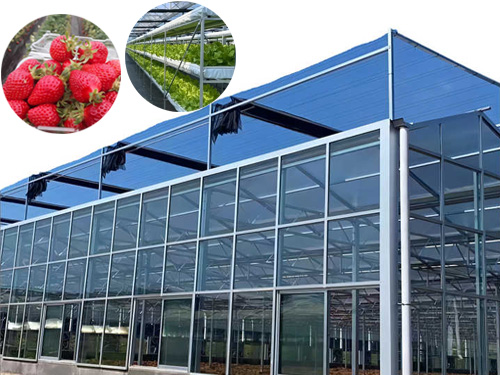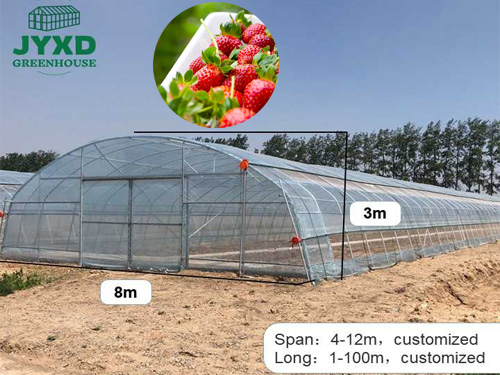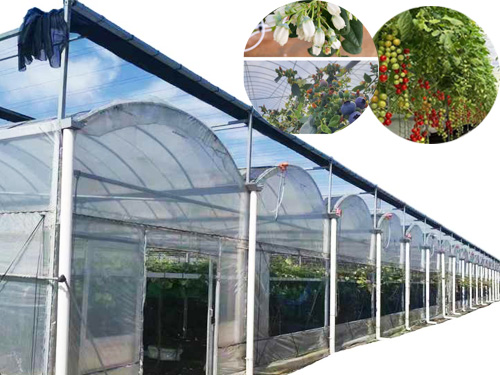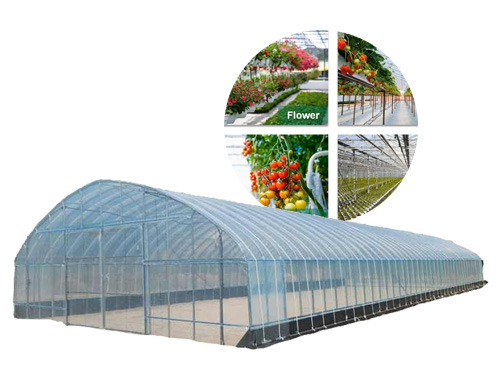NEWS DETAILS
NEWS INFORMATION
What skills should be paid attention to during the construction process of greenhouse?
AUTHOR:jyxd-greenhouse DATE:2024-04-06 14:04:15 HITS:139
Greenhouses are also called greenhouses, such as glass greenhouses, plastic greenhouses, etc. The greenhouse structure should be sealed and insulated, but it should also be easy to ventilate and cool down. Modern greenhouses have equipment to control temperature, humidity, light and other conditions, and use computer automatic control to create the optimal conditions required by plants. For optimal environmental conditions, the following will introduce you to the construction techniques of greenhouses.
1. Leveling the land and setting out lines
According to the designed floor plan of the solar greenhouse, measure the azimuth angle, determine the four corners of the greenhouse, drive piles at the four corners of the greenhouse, and then determine the positions of the gable and back wall.
2. Build a wall
The soil used to build the earth wall can be the soil on the outside of the back wall of the greenhouse, or the soil below the cultivation surface on the front of the greenhouse. If you use deep soil in front of the greenhouse, you can dig out the cultivated layer (about 25 cm thick), put it aside, and water the raw soil at the bottom. After a day, dig out the raw soil to make an earth wall. First make plywood according to the thickness of the earth wall, fill it with the newly excavated wet soil, and compact it with a soil tamper or electric tamper. Each layer is about 20 cm. After compacting one layer, make a second layer until the required height is reached. The gable wall and the back wall should be built together and cannot be divided into sections. Only in this way will they be strong. If the viscosity of the soil is not enough, wheat straw can be mixed into it. The soil viscosity in some areas is very low, and walls cannot be built by tamping. In this case, a certain amount of wheat straw and mud can be mixed into the soil to make adobe. After the adobe is dry, the adobe wall can be built.When building a wall, the spaces between the adobe bricks must be sealed tightly with grass mud, and grass mud must be plastered both inside and outside the wall. When constructing a brick wall, the foundation must be tamped first, and then the wall can be built. During construction, the mortar must be full, the brick joints must be hooked, and the gray surface must be plastered. The inside and outside of the wall must be plastered to avoid air leakage. The voids between layers of brick walls should not be too large or too small. Generally, the width of the hollow is between 5-8 cm. The hollows should not be left to the bottom. Bricks should be used to connect the layers every 3-4 meters to improve the firmness of the wall. The hollow wall can be filled with slag, perlite, and wheat straw, or nothing can be added and only air is used for heat insulation. The hollow wall without filler must be free of cracks. When the bricks are opened and capped, it is best to cap the roof with mud bran by 30 cm to make the back wall and the rear roof closely connected and improve the thermal insulation performance.
3. Buried columns and erecting roof trusses
According to the drawings, determine the position of each column and mark it with lime. Dig a pit 30-40 cm deep, use stones as column bases to prevent the columns from sinking, and then install caskets on the back row of columns. On the pillars, put 3-4 purlins on the pillars. The ridge purlins are connected at the girdle to form a straight line, and other purlins are placed at random. To prevent the purlin from sliding down, a small piece of wood can be nailed to the girdle at the lower part of the purlin to block the purlin wood. Some greenhouses only use columns to support the purlins.
4. Covering the rear roof
Cover the purlins or rafters with a layer of scrap plastic film, and place bundles of corn stalks on the film in a direction perpendicular to the purlins or rafters. Then spread wheat straw or straw on the corn stalks, then spread a layer of plastic film on top, and spread grass mud on top. The rear roof is made of straw and wheat straw wrapped in two layers of plastic film to form a quilt-like covering. The thermal insulation performance is greatly improved compared to the ordinary rear roof without plastic film. After the rear roof is covered, use grass mud to seal the connection between the inner side of the rear roof and the back wall of the greenhouse.
5. Dig cold trenches
Dig a cold-proof trench 20 cm wide and 40 cm deep at the front of the greenhouse.
6. Buried anchors and lamination wires on the rear roof to fix lead wires
At the bottom of the cold-proof ditch, lay a No. 8 lead wire that is as long as the greenhouse, with ground anchors threaded through it. The ground anchors are No. 8 lead wires made into hoops at both ends. According to the spacing between the arch poles to be buried, they should be placed every 3 meters. , tie a brick or wooden stick to the lead wire and place it between these fixtures. On the outside of the back wall of the greenhouse, dig a trench and bury the ground anchors in the same way, except that the distance between the ground anchors can be increased to 2-3 meters. After the ground anchors are buried, they can be filled with soil and the upper ring of the anchor is exposed on the surface. On the back roof of the greenhouse, pull a No. 8 lead wire and bury both ends into the ground outside the greenhouse gable. When burying people, tie heavy objects to the head. Fix the lead wire with lead wire or nylon rope, one end is tied to the lead wire, and the other end is tied to the iron anchor buried outside the back wall.
7. Building the front roof
After the posts are buried, they need to be adjusted front and back so that the rows and columns of the posts are aligned. Tie 4-meter-long bamboo pieces together in pairs. The length should be appropriate. One end should be inserted into the cold-proof ditch, and the lower part should be placed against the south side of the cold-proof ditch. The bricks are tight at the top and angled so that when the arch is erected, it is perpendicular to the ground or slightly inclined to the south. Tie beams to the columns supporting the front roof. The beams are 20-30 cm away from the top of each row of columns. Set up small hanging guis on the beams. Holes must be drilled at the upper and lower ends of the small hanging columns. Use No. 8 lead wire to pass through the holes. , bend the arch rod, one end of the small hanging column is tightly tied to the arch rod, and the other end is supported on the beam and tied tightly. The upper end of the arch rod can be inserted on the ridge purlin. Then, constantly adjust the small hanging posts to make the height of the same position on the front roof consistent.
8. Covering film
The greenhouse film is available in two or three sheets. When two sheets are used, the widths are 3 meters and 5 meters respectively. When three sheets are used, the widths are 2 meters, 4 meters, and 2 meters respectively. First roll back one side of the 3-meter or 2-meter-wide film, glue it with adhesive or iron it into a 5-6 cm wide tube, install it with a mud dragon rope, and fix the 3-meter-wide film 2.5 meters away from the ground. at 2 meters wide and fixed at 1.5 meters from the ground. The film is first rolled into a roll, and while covering and tightening, it is filled with soil into the cold-proof trench. The nylon rope should be tightened and buried together with the film on the gable of the greenhouse. The above one or two pieces of film are also rolled into rolls first, one end is buried in the ground against the gable wall, and then rolled out to the other end, and the end is buried in the ground close to the gable wall. There are two ways to fix the end of the membrane close to the rear roof. One is to use bamboo pieces and iron nails to directly fix it on the ridge purlin; the other method is to use bamboo pieces and iron nails to fix it on the ridge purlin and then fold it back. Fastened to the rear roof. The width of the buckled roof is about 0.5-1 meter, the more the better, and it is compacted with grass mud. This method has a better effect on improving the thermal insulation performance of the rear roof without adding waste film.
9. Fixed laminating line
After the film is covered, it should be pressed and fixed with a lamination line. The lamination line can be a commercially available polypropylene greenhouse special lamination line, or it can be replaced by nylon rope or iron wire, but it is best not to use it. It is best to use a dedicated laminating line. First tie one end of the lamination line to the No. 8 lead wire on the rear roof of the greenhouse, throw it from the greenhouse, press it on the film between the two arch poles, use the anchor ring at the lower end, and tighten it. The order of fixing the laminating lines is first fine and then dense. First fix several laminating lines with a large serration, and then gradually fix a laminating line between each arch. Both the lamination line and the plastic film have a certain degree of elasticity. It should be tightened 2-3 times on the second and third days after the lamination line is fixed to ensure that it is truly compressed. The compressed front roof film will appear wavy. shape.
10. Put on straw thatch and paper quilt
The paper is made of 4-6 layers of kraft paper, and the straw thatch is made of straw or cattail. The width of the straw thatch is 1.2-1.3 meters, and the width of the cattail thatch is 1.5-1.6 meters. The length is based on covering the front roof of the greenhouse. If there is no paper In the case of a quilt, you can cover it with two layers of grass thatch or increase the overlap between the grass thatch. Use two nylon ropes with a length that is twice the length of the grass thatch or slightly longer to pull each piece of grass thatch. Both ends are respectively fixed on one end of the grass thatch, forming two rings to cover the grass thatch. Pull the two ropes on the surface of the straw thatch to roll up or unfold the straw thatch on the front roof of the greenhouse. The rolled up thatch is staggered or placed one behind the other on the rear roof. To prevent the thatch from sliding down, a stone or two or three bricks can be blocked behind each rolled thatch.
11. Handling of Export Population
In a solar greenhouse, a door can be left on the east gable of the greenhouse. The door should be as small as possible, an insulating room should be built outside the door, and curtains should be hung on both the inside and outside of the door. Generally, no door should be left on the west gable or back wall of the greenhouse.
Hebei Juyou Xinda Greenhouse Facilities Co.,Ltd.
Copyright © 2024-2025 https://www.jyxd-greenhouse.com. All Rights Reserved Hebei Juyou Xinda Greenhouse Facilities Co.,Ltd.Copyright





 Current Location:
Current Location: